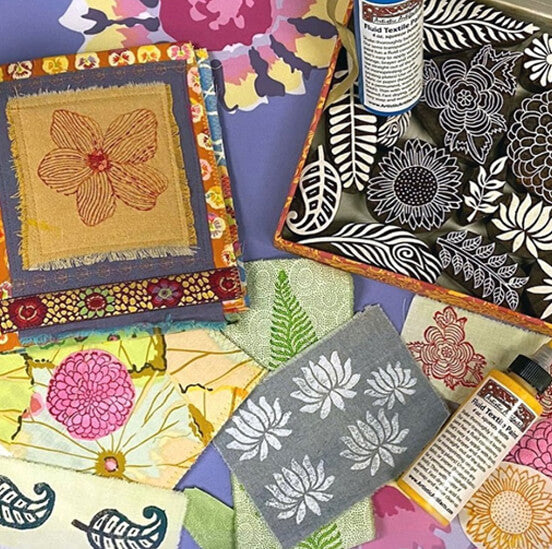Why Do I Need a Round Gelli Plate?
As I watch the different sizes of gel printing plates arrive in the shop, I wonder why we need different shapes and sizes. Do I really need one of each size? Well, after experimenting, I must say yes. Especially to the 8" x 8" Round plate! Why? Because!
Soem of the products I used include:
- Round shape gel printing plate
- Brayer
- Stencils
- Art Journal (I’m using the 9" x 12" Strathmore® Mixed Media Visual Journal)

On my gel printing plate I have placed three different colors of paint. After dabbing them on, I use a brayer to even out the coat of paint on the plate.

When brayering, sometimes you will see the colors stay somewhat distinctive; other times they blend together to create a completely new color, as in the below example.

Cedar Canyon Rubbing Plates are sold in sets of six and are created from a lightweight black plastic that is deeply embossed with patterns. They are available in a number of designs; pictured below is Op Art.

Select a rubbing plate, and lightly press it onto the paint-covered gel printing plate surface, then and lift straight up. Below is the plate with paint “removed” from one of the rubbing plates from the Doodles set.

Pick up your printing plate and place it face down atop one of your journal pages. Notice below how I have offset it so it “bleeds” off the edge of the page.

Press lightly across the plate, then lift it gently off your journal. (You could also leave the plate in place and press your journal, paper or fabric down onto it.)

Below, I added another circle to the same page.

Another rubbing plate print, this one of the plates from the Floral Fantasy set... does it look like it is twirling to you?

Below, the gel printing plate coated with paint and my free-handing a design.

I think I need additional practice with free-hand pattern making.

Another great tool to use with gelli plates are stencils. In this example I used a large 12" x 12", which allows me to continue the pattern right up to and over the edge.


Here are three green monoprints, all using the same stencil. Of the two that are pictured below, I think the one on the left had too much paint applied to the Gel Printing Plate.
It does take some trial and error time and practice to get the application of paint onto the plate correct. But it’s not exactly torture to spend time playing!

Up to this point I haven’t written about the paint I am using. Silks Acrylic Glazes have a high mica formulation and give you a nice finish shine ...not too much, but just right. They are translucent and designed to blend over any other Silks shade without going muddy.

The other cool thing about these paints is that once dry, they act as a resist to combining with Twinkling H20’s, which are a watercolor. Again, the colors stay true and jewel-like. Below is the above print with the addition of additional Silks and Twinkling H20’s.

I began thinking that the leaf print from the stencil was blending in a bit too much (but not muddy, right?) and wanted to bring it back to the surface. So I pulled out a favorite white pen, the Gelly Roll Soufflé Opaque Puffy Ink Pen, to hand-trace the pattern. (This is one of the pens we will be experimenting with during our monthly “How Do I Use This?” demonstrations and play-time.)

So, I have I talked you into “needing” a round Gel Printing Plate too? If you’re interested in exploring monoprinting, I heartily recommend our upcoming class, Gelli Printing on Paper with Susan Gantz. Susan is an amazing teacher who loves to share her enthusiasm for this amazing art form. Plates, paints and more are provided, and we have heard nothing but raves about this class...every student walks out with a sheaf of amazing monoprints we all oooh and ahhh over!








Leave a comment